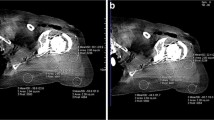Abstract
Objective
To determine the utility of iterative metal artifact reduction and 130 keV dual-energy virtual monoenergetic images to improve bone and soft tissue visualization in CT scans affected by metal artifacts.
Material and methods
Thirteen females and 6 males with a history of total shoulder prosthesis who underwent dual-energy shoulder CT were included. Four sets of images were reconstructed for each patient: (1) original polychromatic kV images reconstructed with weighted filtered back projection; (2) polychromatic kV images with iterative metal artifact reduction; (3) 130 keV dual-energy virtual monoenergetic; (4) combined iterative metal artifact reduction and 130 keV dual-energy virtual monoenergetic. Three readers blindly reviewed all image sets and graded the extent of artifact and image quality.
Results
Mean artifact score and median overall image quality score were better in 130 keV dual-energy virtual monoenergetic with iterative metal artifact reduction compared with those in original polychromatic kV images (3.02 vs 4.28, P < 0.001 and 3.00 vs 4.33, P < 0.001, respectively). The median difference in CT numbers between regions affected by artifacts and normal regions was lowest in 130 keV dual-energy virtual monoenergetic with iterative metal artifact reduction compared with that in original polychromatic kV images (72.28 vs 252.08, P < 0.001 for bony regions and 15.09 vs 324.38, P < 0.001 for soft tissue).
Conclusion
In patients with metal artifacts due to shoulder replacement surgery, the use of dual-energy monoenergetic images and iterative metal artifact reduction reconstruction significantly improves both subjective and objective indicators of image quality.



Similar content being viewed by others
References
Neer CS, Brown TH Jr, McLaughlin HL. Fracture of the neck of the humerus with dislocation of the head fragment. Am J Surg. 1953;85(3):252–8.
Palsis JA, Simpson KN, Matthews JH, Traven S, Eichinger JK, Friedman RJ. Current trends in the use of shoulder arthroplasty in the United States. Orthopedics. 2018;41(3):e416–23.
Kim SH, Wise BL, Zhang YQ, Szabo RM. Increasing incidence of shoulder arthroplasty in the United States. J Bone Joint Surg Am. 2011;93a(24):2249–54.
Gupta A, Subhas N, Primak AN, Nittka M, Liu K. Metal artifact reduction: standard and advanced magnetic resonance and computed tomography techniques. Radiol Clin N Am. 2015;53(3):531–47.
Gregory T, Hansen U, Khanna M, Mutchler C, Urien S, Amis AA, et al. A CT scan protocol for the detection of radiographic loosening of the glenoid component after total shoulder arthroplasty. Acta Orthop. 2014;85(1):91–6.
Lin DJ, Wong TT, Kazam JK. Shoulder arthroplasty, from indications to complications: what the radiologist needs to know. Radiographics. 2016;36(1):192–208.
Barrett JF, Keat N. Artifacts in CT: recognition and avoidance. Radiographics. 2004;24(6):1679–91.
Khodarahmi I, Haroun RR, Lee M, Fung GSK, Fuld MK, Schon LC, et al. Metal artifact reduction computed tomography of arthroplasty implants: effects of combined modeled iterative reconstruction and dual-energy virtual monoenergetic extrapolation at higher photon energies. Investig Radiol. 2018;53(12):728–35.
Mangold S, Gatidis S, Luz O, Konig B, Schabel C, Bongers MN, et al. Single-source dual-energy computed tomography: use of monoenergetic extrapolation for a reduction of metal artifacts. Investig Radiol. 2014;49(12):788–93.
Subhas N, Polster JM, Obuchowski NA, Primak AN, Dong FF, Herts BR, et al. Imaging of arthroplasties: improved image quality and lesion detection with iterative metal artifact reduction, a new CT metal artifact reduction technique. AJR Am J Roentgenol. 2016;207(2):378–85.
Shim E, Kang Y, Ahn JM, Lee E, Lee JW, Oh JH, et al. Metal artifact reduction for orthopedic implants (O-MAR): usefulness in CT evaluation of reverse total shoulder arthroplasty. AJR Am J Roentgenol. 2017;209(4):860–6.
Higashigaito K, Angst F, Runge VM, Alkadhi H, Donati OF. Metal artifact reduction in pelvic computed tomography with hip prostheses: comparison of virtual monoenergetic extrapolations from dual-energy computed tomography and an iterative metal artifact reduction algorithm in a phantom study. Investig Radiol. 2015;50(12):828–34.
Kotsenas AL, Michalak GJ, DeLone DR, Diehn FE, Grant K, Halaweish AF, et al. CT metal artifact reduction in the spine: can an iterative reconstruction technique improve visualization? AJNR Am J Neuroradiol. 2015;36(11):2184–90.
Diehn FE, Michalak GJ, DeLone DR, Kotsenas AL, Lindell EP, Campeau NG, et al. CT dental artifact: comparison of an iterative metal artifact reduction technique with weighted filtered back-projection. Acta Radiol Open. 2017;6(11):2058460117743279.
Yoo HJ, Hong SH, Chung BM, Moon SJ, Choi JY, Chae HD, et al. Metal artifact reduction in virtual monoenergetic spectral dual-energy CT of patients with metallic orthopedic implants in the distal radius. AJR Am J Roentgenol. 2018;211(5):1083–91.
Bongers MN, Schabel C, Thomas C, Raupach R, Notohamiprodjo M, Nikolaou K, et al. Comparison and combination of dual-energy- and iterative-based metal artefact reduction on hip prosthesis and dental implants. PLoS One. 2015;10(11):e0143584.
Acknowledgments
The authors are grateful to Michael Bruesewitz, R.T.(R) and Scott Boeke, D.O. for their assistance in data collection.
Author information
Authors and Affiliations
Corresponding author
Ethics declarations
Institutional review board approval was obtained for this study, which was in compliance with the Health Insurance Portability and Accountability Act.
Conflict of interest
The authors declare that they have no conflict of interest.
Additional information
Publisher’s note
Springer Nature remains neutral with regard to jurisdictional claims in published maps and institutional affiliations.
Rights and permissions
About this article
Cite this article
Mohammadinejad, P., Baffour, F.I., Adkins, M.C. et al. Benefits of iterative metal artifact reduction and dual-energy CT towards mitigating artifact in the setting of total shoulder prostheses. Skeletal Radiol 50, 51–58 (2021). https://doi.org/10.1007/s00256-020-03528-3
Received:
Revised:
Accepted:
Published:
Issue Date:
DOI: https://doi.org/10.1007/s00256-020-03528-3




